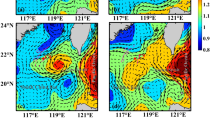Summary
Refinements in modeling stratospheric processes and recent observational data have generated estimates of moderate future reductions in total global ozone. Nevertheless, considerable uncertainty and concern remain about whether or not the resulting increases in incident solar UV-B could increase the risk of harmful biological effects. The UV-B dose/dose-rate thresholds for five species of copepods collected at the surface in Puget Sound were determined and compared to previously studied zooplankton groups. Generally, species appearing later in the spring and summer were less UV-B sensitive. The UV-B daily-dose and dose-rate thresholds for the five species of copepods, while apparently less than present median incident levels, range from above to below estimated present and future subsurface (1 m) UV-B levels. A separate experiment with a relatively large copepod, Calanus pacificus, in which above and below threshold UV-B dose-rates were administered with various levels of photoreactivating light(UV-A and visible light), indicated the presence of photorepair and its full activation at relatively low intensity. To improve estimates of the extent to which present and predicted UV-B levels affect local populations of copepods and zooplankton, it is essential to more fully understant the natural conditions or processes which influence the composition and intensity of the UV irradiation these animals receive.
Similar content being viewed by others
References
Bradford JM (1976) Partial revision of the Acartia subgenus Acartiura (Copepoda: Calanoida: Acartiidae). New Zealand J Mar Freshwater Res 10(1):159–202
Brodsky KA (1957) Fauna veslonogikh rachov (Calanoida) i zoogeograficheskoe raionirovanie severnoi chasti Tikhogo Okeanna i sopredel'nykh vod [Fauna Copepoda (Calanoida) and zoogeographical divisions of the North Pacific Ocean and adjacent waters]. Izd Akad Nauk SSSR Moscow, 222 pp
Damkaer DM (1982) Possible influences of solar UV radiation in the evolution of marine zooplankton. In: Calkins J (ed) The role of solar ultraviolet radiation in marine ecosystems; NATO Conf Ser 4 Mar Sci, Vol 7. Plenum Press, New York-London pp 701–706
Damkaer DM, Dey DB (1982) Short-term responses of some planktonic Crustacea exposed to enhanced UV-B radiation. In: Calkins J (ed) The role of solar ultraviolet radiation in marine ecosytems; NATO Conf Ser 4 Mar Sci, Vol 7. Plenum Press New York-London pp 417–427, 470
Damkaer DM, Dey DB (1983) UV damage and photoreactivation potentials of larval shrimp, Pandalus platyceros, and adult euphausiids, Thysanoessa raschii. Oecologia (Berlin) 60:169–175
Damkaer DM, Dey DB, Heron GA (1981) Dose/dose-rate responses of shrimp larvae to UV-B radiation. Oecologia (Berlin) 48:178–182
Damkaer DM, Dey DB, Heron GA, Prentice EF (1980) Effects of UV-B radiation on near-surface zooplankton of Puget Sound. Oecologia (Berlin) 44:149–158
Frost BW (1977) Feeding behavior of Calanus pacificus in mixtures of food particles. Limnol Oceanogr 22:472–491
Gerstl SAW, Zardecki A, Wiser HL (1981) Biologically damaging radiation amplified by ozone depletions. Nature 294:352–354
Hairston N (1980) The vertical distribution of diaptomid copepods in relation to body pigmentation. In: Kerfoot W (ed) Evolution and ecology of zooplankton communities. Hanover, NH. Univ Press New England pp 98–110, 793
Karanas JJ, Van Dyke H, Worrest RC (1979) Midultraviolet (UV-B) sensitivity of Acartia clausii Giesbrecht (Copepoda). Limnol Oceanogr 24:1104–1116
Karanas JJ, Worrest RC, Van Dyke H (1981) Impact of UV-B radiation on the fecundity of the copepod Acartia clausii. Mar Biol 65:125–133
Kaupp SE, Hunter JR (1981) Photorepair in larval anchovy, Engraulis mordax. Photochem Photobiol 33:253–256
Motoda S (1963) Corycaeus and Farranula (Copepoda, Cyclopoida) in Hawaiian waters. Publ Seto Mar Biol Lab 11(2):209–262
NRC (1979) Protection against depletion of stratospheric ozone by chlorfluorocarbons. Nat Acad Sci, Washington, DC 392 pp
NRC (1982) Causes and effects of stratospheric ozone reduction: an updata. Nat Acad Press, Washington, DC 339 pp
NRC (1984) Causes and effects of changes in stratospheric ozone: update 1983. Nat Acad Press, Washington, DC 254 pp
Ringelberg J, Keyser A, Flik B (1984) The mortality effect of ultraviolet radiation in a translucent and in a red morph of Acanthodiaptomus denticornis (Crustacea, Copepoda) and its possible ecological relevance. Hydrobiologia 112:217–222
Smith RC, Baker KS (1979) Penetration of UV-B and biologically effective dose-rates in natural waters. Photochem Photobiol 29:311–323
Watson RT, Geller MA, Stolarski RS, Hampson RF (1986) Present state of knowledge of the upper atmosphere: an assessment report. NASA Reference Publication 1162:1–154
Author information
Authors and Affiliations
Additional information
Contribution No. 1760 from the School of Oceanography, University of Washington, Seattle, WA 98195, USA
Rights and permissions
About this article
Cite this article
Dey, D.B., Damkaer, D.M. & Heron, G.A. UV-B dose/dose-rate responses of seasonally abundant copepods of Puget Sound. Oecologia 76, 321–329 (1988). https://doi.org/10.1007/BF00377024
Received:
Issue Date:
DOI: https://doi.org/10.1007/BF00377024




